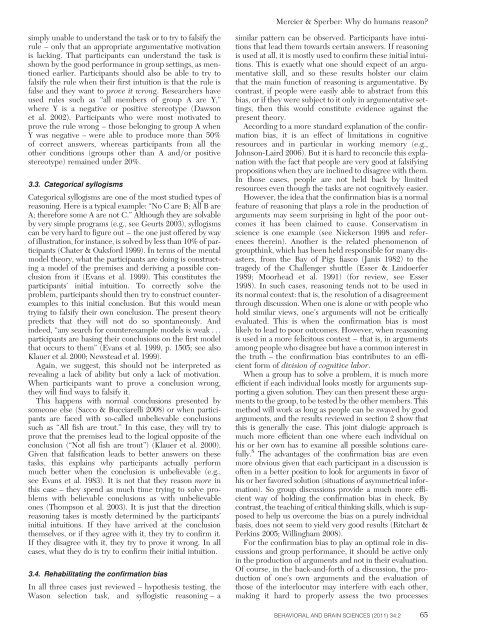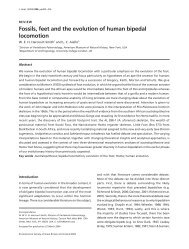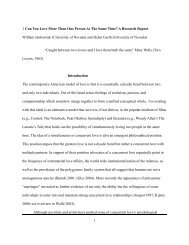Why do humans reason? Arguments for an argumentative theory
Why do humans reason? Arguments for an argumentative theory
Why do humans reason? Arguments for an argumentative theory
Create successful ePaper yourself
Turn your PDF publications into a flip-book with our unique Google optimized e-Paper software.
Mercier & Sperber: <strong>Why</strong> <strong>do</strong> <strong>hum<strong>an</strong>s</strong> <strong>reason</strong>?simply unable to underst<strong>an</strong>d the task or to try to falsify therule – only that <strong>an</strong> appropriate <strong>argumentative</strong> motivationis lacking. That particip<strong>an</strong>ts c<strong>an</strong> underst<strong>an</strong>d the task isshown by the good per<strong>for</strong>m<strong>an</strong>ce in group settings, as mentionedearlier. Particip<strong>an</strong>ts should also be able to try tofalsify the rule when their first intuition is that the rule isfalse <strong>an</strong>d they w<strong>an</strong>t to prove it wrong. Researchers haveused rules such as “all members of group A are Y,”where Y is a negative or positive stereotype (Dawsonet al. 2002). Particip<strong>an</strong>ts who were most motivated toprove the rule wrong – those belonging to group A whenY was negative – were able to produce more th<strong>an</strong> 50%of correct <strong>an</strong>swers, whereas particip<strong>an</strong>ts from all theother conditions (groups other th<strong>an</strong> A <strong>an</strong>d/or positivestereotype) remained under 20%.3.3. Categorical syllogismsCategorical syllogisms are one of the most studied types of<strong>reason</strong>ing. Here is a typical example: “No C are B; All B areA; there<strong>for</strong>e some A are not C.” Although they are solvableby very simple programs (e.g., see Geurts 2003), syllogismsc<strong>an</strong> be very hard to figure out – the one just offered by wayof illustration, <strong>for</strong> inst<strong>an</strong>ce, is solved by less th<strong>an</strong> 10% of particip<strong>an</strong>ts(Chater & Oaks<strong>for</strong>d 1999). In terms of the mentalmodel <strong>theory</strong>, what the particip<strong>an</strong>ts are <strong>do</strong>ing is constructinga model of the premises <strong>an</strong>d deriving a possible conclusionfrom it (Ev<strong>an</strong>s et al. 1999). This constitutes theparticip<strong>an</strong>ts’ initial intuition. To correctly solve theproblem, particip<strong>an</strong>ts should then try to construct counterexamplesto this initial conclusion. But this would me<strong>an</strong>trying to falsify their own conclusion. The present <strong>theory</strong>predicts that they will not <strong>do</strong> so spont<strong>an</strong>eously. Andindeed, “<strong>an</strong>y search <strong>for</strong> counterexample models is weak ...particip<strong>an</strong>ts are basing their conclusions on the first modelthat occurs to them” (Ev<strong>an</strong>s et al. 1999, p. 1505; see alsoKlauer et al. 2000; Newstead et al. 1999).Again, we suggest, this should not be interpreted asrevealing a lack of ability but only a lack of motivation.When particip<strong>an</strong>ts w<strong>an</strong>t to prove a conclusion wrong,they will find ways to falsify it.This happens with normal conclusions presented bysomeone else (Sacco & Bucciarelli 2008) or when particip<strong>an</strong>tsare faced with so-called unbelievable conclusionssuch as “All fish are trout.” In this case, they will try toprove that the premises lead to the logical opposite of theconclusion (“Not all fish are trout”) (Klauer et al. 2000).Given that falsification leads to better <strong>an</strong>swers on thesetasks, this explains why particip<strong>an</strong>ts actually per<strong>for</strong>mmuch better when the conclusion is unbelievable (e.g.,see Ev<strong>an</strong>s et al. 1983). It is not that they <strong>reason</strong> more inthis case – they spend as much time trying to solve problemswith believable conclusions as with unbelievableones (Thompson et al. 2003). It is just that the direction<strong>reason</strong>ing takes is mostly determined by the particip<strong>an</strong>ts’initial intuitions. If they have arrived at the conclusionthemselves, or if they agree with it, they try to confirm it.If they disagree with it, they try to prove it wrong. In allcases, what they <strong>do</strong> is try to confirm their initial intuition.3.4. Rehabilitating the confirmation biasIn all three cases just reviewed – hypothesis testing, theWason selection task, <strong>an</strong>d syllogistic <strong>reason</strong>ing – asimilar pattern c<strong>an</strong> be observed. Particip<strong>an</strong>ts have intuitionsthat lead them towards certain <strong>an</strong>swers. If <strong>reason</strong>ingis used at all, it is mostly used to confirm these initial intuitions.This is exactly what one should expect of <strong>an</strong> <strong>argumentative</strong>skill, <strong>an</strong>d so these results bolster our claimthat the main function of <strong>reason</strong>ing is <strong>argumentative</strong>. Bycontrast, if people were easily able to abstract from thisbias, or if they were subject to it only in <strong>argumentative</strong> settings,then this would constitute evidence against thepresent <strong>theory</strong>.According to a more st<strong>an</strong>dard expl<strong>an</strong>ation of the confirmationbias, it is <strong>an</strong> effect of limitations in cognitiveresources <strong>an</strong>d in particular in working memory (e.g.,Johnson-Laird 2006). But it is hard to reconcile this expl<strong>an</strong>ationwith the fact that people are very good at falsifyingpropositions when they are inclined to disagree with them.In those cases, people are not held back by limitedresources even though the tasks are not cognitively easier.However, the idea that the confirmation bias is a normalfeature of <strong>reason</strong>ing that plays a role in the production ofarguments may seem surprising in light of the poor outcomesit has been claimed to cause. Conservatism inscience is one example (see Nickerson 1998 <strong>an</strong>d referencestherein). Another is the related phenomenon ofgroupthink, which has been held responsible <strong>for</strong> m<strong>an</strong>y disasters,from the Bay of Pigs fiasco (J<strong>an</strong>is 1982) to thetragedy of the Challenger shuttle (Esser & Lin<strong>do</strong>erfer1989; Moorhead et al. 1991) (<strong>for</strong> review, see Esser1998). In such cases, <strong>reason</strong>ing tends not to be used inits normal context: that is, the resolution of a disagreementthrough discussion. When one is alone or with people whohold similar views, one’s arguments will not be criticallyevaluated. This is when the confirmation bias is mostlikely to lead to poor outcomes. However, when <strong>reason</strong>ingis used in a more felicitous context – that is, in argumentsamong people who disagree but have a common interest inthe truth – the confirmation bias contributes to <strong>an</strong> efficient<strong>for</strong>m of division of cognitive labor.When a group has to solve a problem, it is much moreefficient if each individual looks mostly <strong>for</strong> arguments supportinga given solution. They c<strong>an</strong> then present these argumentsto the group, to be tested by the other members. Thismethod will work as long as people c<strong>an</strong> be swayed by goodarguments, <strong>an</strong>d the results reviewed in section 2 show thatthis is generally the case. This joint dialogic approach ismuch more efficient th<strong>an</strong> one where each individual onhis or her own has to examine all possible solutions carefully.8 The adv<strong>an</strong>tages of the confirmation bias are evenmore obvious given that each particip<strong>an</strong>t in a discussion isoften in a better position to look <strong>for</strong> arguments in favor ofhis or her favored solution (situations of asymmetrical in<strong>for</strong>mation).So group discussions provide a much more efficientway of holding the confirmation bias in check. Bycontrast, the teaching of critical thinking skills, which is supposedto help us overcome the bias on a purely individualbasis, <strong>do</strong>es not seem to yield very good results (Ritchart &Perkins 2005; Willingham 2008).For the confirmation bias to play <strong>an</strong> optimal role in discussions<strong>an</strong>d group per<strong>for</strong>m<strong>an</strong>ce, it should be active onlyin the production of arguments <strong>an</strong>d not in their evaluation.Of course, in the back-<strong>an</strong>d-<strong>for</strong>th of a discussion, the productionof one’s own arguments <strong>an</strong>d the evaluation ofthose of the interlocutor may interfere with each other,making it hard to properly assess the two processesBEHAVIORAL AND BRAIN SCIENCES (2011) 34:2 65




